It all began suddenly with the onset of a fever that left her weak, unable to eat and barely able to stand. At two years of age, little Arleen Rigaud of New Orleans had been playing in the yard until called to dinner. Alarmed, Corporal Edwin Rigaud took his daughter’s temperature and found it to be abnormally high. A short while later, Arleen was admitted to the polio ward at Charity Hospital. She was another victim of polio, one of the most terrifying diseases in the first half of the 20th century.
For the next nine months, little Arleen Rigaud would remain in the Kenny Unit at Charity Hospital. The unit was established in 1942 to treat polio patients in Louisiana, including people of color, although the wards were strictly segregated.
Elsewhere in the Jim Crow South, some hospitals would not just relegate black children to separate quarters, but even turn them away. Tuskegee Institute was the only place in the country built specifically to treat black children with polio. Tuskegee opened its polio center in 1941, funded by the March of Dimes. Its purpose was to provide the most modern treatment for Negro infantile paralysis victims, and to train Negro doctors and surgeons for orthopedic work, as well as nurses and physical therapists. Those trained doctors would play a crucial role in the war on polio.
The best method of treating patients was to use heated strips of moist cloth placed over the patient’s affected areas. Physical therapy was also used such as bending and flexing of the joints. In earlier treatments, doctors used splints and braces to prevent muscle tightening.
Luckily, little Arleen Rigaud came home after 9 months, cured and able to live a productive life. Her case (first stage) was mild, which means the polio infection never reached her central nervous system. If it had, then the cells that control the muscles would be damaged and could lead to permanent paralysis.
As far back as June 1916, a polio epidemic was officially declared in the United States. In New York, for example, the city responded aggressively to control the spread of the disease. Every day, the newspapers published the names and addresses of people known to have the disease. Placards were nailed to their doors and families were quarantined. Movie theaters were closed, public gatherings were cancelled, and thousands fled to escape the epidemic.
By 1928, the “Iron Lung” machine was developed for severe polio patients whose lung muscles were so paralyzed they could no longer breathe on their own. It was often described as a coffin-like box that encased patients from their neck to toes. Many regained the use of their lungs but some with permanent paralysis had to remain in this device for the rest of their lives. Years later, the old iron lung would be replaced by modern ventilators.
Prior to 1932, when the first iron lung in New Orleans was donated to Touro Infirmary, the nearest machine was in Houston. In 1939, both Hotel Dieu and Charity Hospital acquired iron lungs. By 1948, there were four in the city. In that same year, two oxygen tents were donated to Flint-Goodridge Hospital, which did not have the facilities to accommodate an iron lung unit.
Polio wreaked havoc among American children every summer. An article in The Times-Picayune in 1950 tried to dispel many myths that were being spread in New Orleans. Among the notions refuted in the article were that flies spread the virus or that any particular food or drinks were implicated in the spread of the disease. Swallowing pool water would not give children polio nor would neighborhood playmates, movie theaters, or school attendance.
Left to right: Beryl Segre, Gilda D’aunoy, Gail Henderson, and Gilda Landry at the Bernice Durden Franklin Dance Revue benefit for Polio in the Booker T. Washington Auditorium. (The Louisiana Weekly, 4 November 1949)
It was known that polio appeared to be a summer disease and could affect anyone, but it caused the worst damage among children under five years old. It was also known that polio was caused by a virus and passed through contaminated water. No cure was known, only its symptoms. Paranoid parents kept their children inside throughout the summer months.
President Franklin D. Roosevelt was stricken with polio in 1938 and was confined to a wheelchair for the rest of his life. To eradicate the terrible disease, he created the National Foundation for Infantile Paralysis, which was funded by the “March of Dimes.” Americans began emptying their pockets, and the money added up. Eighty thousand letters with dimes and dollars flooded the White House mailroom. By 1945, the annual March of Dimes raised 18.9 million dollars for polio research. By 1952, sixty thousand children in the country had contacted polio, of whom 3,000 died.
At long last in early 1953, medical researcher Dr. Jonas Salk created a polio vaccine that when injected with a needle, stimulated the immune system to make antibodies that fought off the polio virus. Two years later, the polio vaccine was licensed in the United States and the first dosage arrived at the Mayo Clinic on 13 April 1955.
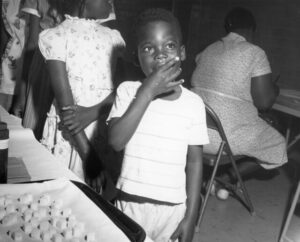
Sugar cube vaccinations on a tray as a child takes his dose in 1967. Photo by United States Public Health Service. Courtesy of RBM Vintage Images / Alamy.
A few years later, Dr. Albert Sabin created an oral vaccine which was dispensed in the form of a sugar cube and distributed to students at school. The release of the vaccine and the campaign to educate the public on the need and values of the vaccine, led to the eradication of polio in the United States by 1979.
The nearly seventy years of fear, illness, and deaths brought about by polio convinced several generations of the efficacy of vaccines. The recent Covid-19 pandemic should serve as a contemporary reminder of the necessity of heeding the directives of public health officials.
Lolita Villavasso Cherrie
Sources: The Times-Picayune, 11 July1950, p.12; The Times-Picayune, 28 July 1948, p. 16; The New Orleans States, 14 July 1953, p.7; sciencemuseum.org/medicine/polio; history.com/Franklin-Roosevelt; ncbi.nlm.nih.gov/pmc/articles/pmc1854857; polioplace.org/Tuskegee; nationalww2museum.org/polio-medical-intervention.
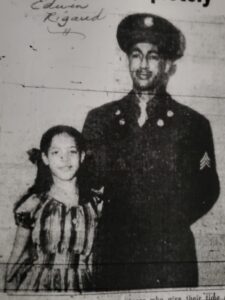
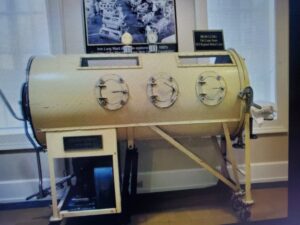
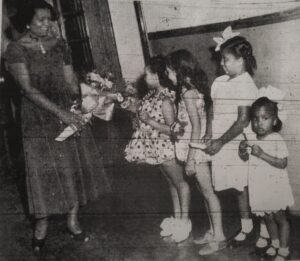
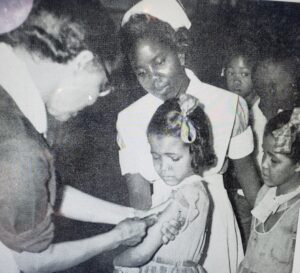



Sounds like my story for I too contracted polio at age 4. I too was fortunate to have avoided any major effects of the disease and could lead a normal life after recovery. I later went on to obtain degrees in Microbiology and Immunology prompted by the experience of having been affected by the virus.
You are blessed and amazing and so very glad that Polio is now eradicated in most countries all over the world. I remember when the Polio meds were given by sugar cubes here in NC, because me and my brothers each got one from our family doctor, the late Dr. William Long. He was not only our family doctor but was in Patton’s Army. He also knew the late General George Patton and Daddy was placed in Patton’s Army during the Battle of the Bulge as a part of the last effort to win WWII by actually integrating the troops. I come from a family of nurses on my mom’s side going back almost 100 years here in NC, with a cadet nurse who was my Grandmother’s great niece the late Delaine Tabor Fleming who became an RN in 1970 at North Carolina Central University in Durham which has a wonderful nursing education program.
I received the SALK vaccine in November 1955 and 2 doses of the Oral Sabin Vaccine while at college at Xavier Universty. Dr. Jonas Salk’s wife, Donna was on the Tuskegee Institute Board of Trustees when I was in the College of Veterinary Medicine from 1965-1969.
I too remember this deadly disease, kids wearing braces. I recall visiting a polio treatment facility in Sanatorium, Ms. to see someone in an iron lung. The room was full of these machines, also took the sugar cube vaccine at a segregated school on the weekend. I remember well. it was scary times.
My Brother was born in 1946. Came down with polio when he was 5 or 6. Mom woke him up for school that morning and he was taking too long to get out of bed. So she went back in his room and told him to get up. He said my legs won’t move. He needed braces and therapy which my Parents paid out of pocket. I don’t know how long it took for him to get better. He was my big brother 9 years older than me. When I was 7 or 8 I asked why he walked in a hip way. He told me that was to cover up his limp. He went on to serve in the Air Force for 4 years and the New Orleans Fire Dept. He never let his limp stop him. The only thing is that he could never donate blood because of the Polio.
Your brother was a very heroic young man! He never gave up. This is why vaccines are so important. Thank you for sharing your story. (Lolita)